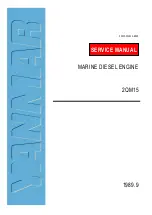
6 Connection
−
28
−
Connecting the I/O
Connecting the I/O signal wires into the driver’s I/O terminal blocks (TB3). Screw
terminals are used. Remove the insulation from the core, then insert the core into the
terminal and tighten with terminal screws. Strip 5 mm (0.2 in.) of insulation. Tighten
the terminal screw to the specified tightening torque.
Use a cable of AWG 24 to 20 for the I/O line.
Tightening torque: 0.22 to 0.25 N·m (1.95 to 2.2 lb-in)
•
Terminal blocks pin assignments (TB3)
No. Signal
name
Description
1 PLS+
input
2 PLS
−
input
CW pulse input
3 DIR+
input
4 DIR
−
input
Rotation direction input
5 AWO+
input
6 AWO
−
input
All windings off input
7 TIM+
input
8 TIM
−
input
Timing output
9 NC
Not
use
6.3 About input/output
Input signals
All input signals of the driver are photocoupler inputs.
The signal state represents the “ON: Carrying current” or “OFF: Not carrying
current” state of the internal photocoupler rather than the voltage level of the signal.
PLS (CW)
DIR (CCW)
AWO
R
1
Controller output
Driver internal circuits
+
-
220
Ω
10 to 20 mA
0 V
V
0
Use 5 VDC as the input signal voltage. When the input signal voltage V
0
is equal to
5 VDC, the external resistances R
1
is not necessary. When V
0
is above 5 VDC,
connect R
1
to keep the input current 10 to 20 mA.
V
0
20 mA
R
1
=
- 220 [
Ω
]
















































